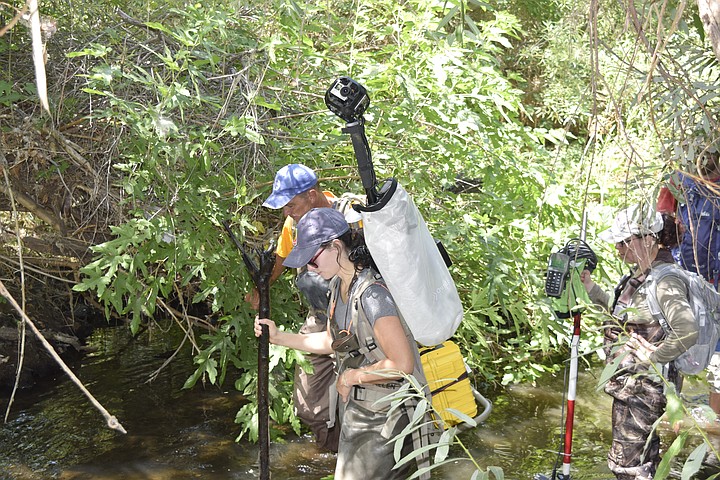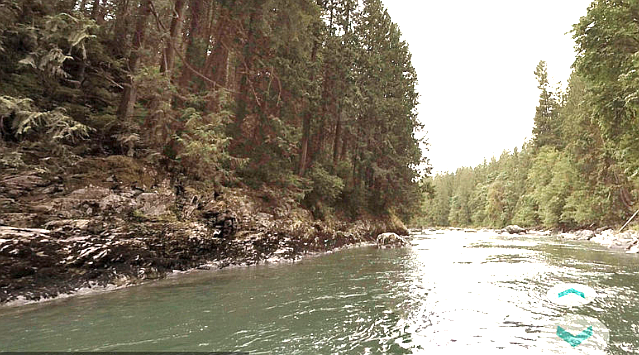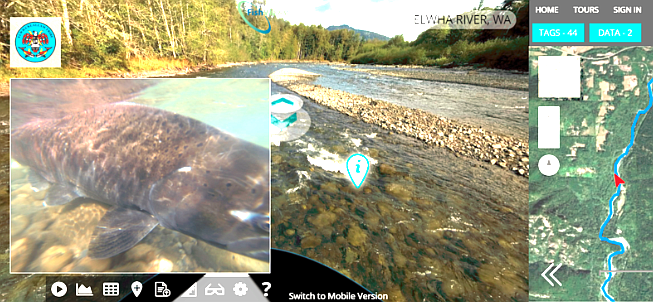 Facebook
Facebook
 X
X
 Instagram
Instagram
 TikTok
TikTok
 Youtube
Youtube

Nature lovers around the globe will soon be able to experience the San Diego River in a virtual environment. Staff, interns, and volunteers from the San Diego River Park Foundation have been traveling the waterway and its tributaries, collecting images and data.

The mostly unpaid team has so far covered just over 10 miles of the 52-mile river since they began in June. Now that they’ve reached that milestone, the foundation’s tech partner will begin stitching the data together to create its virtual doppelganger. Once the model is finished, it will be available online for interactive use by the public.

Andrew Meyer, a field coordinator for the foundation, says, “Just like Google Streetview, viewers will be able to zoom down the river and access parts of the river that they’ve never seen before,” Meyer said.

The San Diego River Park Foundation has partnered with a company, also called FishViews, to complete the project. Brian Footen, president of FishViews, helped Meyer teach volunteers and interns how to operate the equipment, which is housed in a custom backpack and on an instrument-bearing surveying staff. The system can be mounted on a small boat to capture data and images in deeper water.

The equipment includes a 360-degree camera that is customized to integrate with a GPS-tracked data logging system as the river is traveled by foot or boat. An underwater camera captures “snorkel-view” images while water quality sensors measure pH, dissolved oxygen, temperature, salinity, and other variables. While the equipment is operating, every five seconds all the cameras simultaneously take an image and the sensors record their metrics. Once the data has been collected, software processes it into a three-dimensional environment that can be explored online with virtual reality glasses.
Most of riverbed will be covered by foot—wading through the shallows while carrying the equipment. An afternoon of work usually maps less than one mile of the river. Overhanging brush and tree limbs can obstruct the mast with cameras, requiring some deep bending and deft maneuvering to make passage. Footing can be slippery. The river bottom is at times rocky and uneven alternating with squishy muck. Fallen trees must be scrambled over or navigated around. Eyeglasses are fogged by the humidity of the river and vegetation, and gnats and mosquitos hover.
Footen, who has 25 years of experience as a fishery scientist, said he began FishViews nearly four years ago.
The company’s first project used drones to capture aerial images of salmon streams in the Northwest. Footen said they realized that more data would be more valuable and began designing the surveying system. The company has mapped more than 1,200 miles of river, mostly in Texas and Washington.
The foundation plans to continue surveying until it has covered about two-thirds of the total distance, skipping tribal lands and private property. Expeditions are being made approximately weekly, with a minimum of three team members per half-day trip. Sections of the river, from the estuary near Ocean Beach to the headwaters near Julian, are being covered based on the availability and location of volunteers. This week, the team is mapping the River Walk Golf Course, which will complete the data collection for the Mission Valley portion of the river. The San Diego River Park Foundation hopes to complete the project by next summer.


Nature lovers around the globe will soon be able to experience the San Diego River in a virtual environment. Staff, interns, and volunteers from the San Diego River Park Foundation have been traveling the waterway and its tributaries, collecting images and data.

The mostly unpaid team has so far covered just over 10 miles of the 52-mile river since they began in June. Now that they’ve reached that milestone, the foundation’s tech partner will begin stitching the data together to create its virtual doppelganger. Once the model is finished, it will be available online for interactive use by the public.

Andrew Meyer, a field coordinator for the foundation, says, “Just like Google Streetview, viewers will be able to zoom down the river and access parts of the river that they’ve never seen before,” Meyer said.

The San Diego River Park Foundation has partnered with a company, also called FishViews, to complete the project. Brian Footen, president of FishViews, helped Meyer teach volunteers and interns how to operate the equipment, which is housed in a custom backpack and on an instrument-bearing surveying staff. The system can be mounted on a small boat to capture data and images in deeper water.

The equipment includes a 360-degree camera that is customized to integrate with a GPS-tracked data logging system as the river is traveled by foot or boat. An underwater camera captures “snorkel-view” images while water quality sensors measure pH, dissolved oxygen, temperature, salinity, and other variables. While the equipment is operating, every five seconds all the cameras simultaneously take an image and the sensors record their metrics. Once the data has been collected, software processes it into a three-dimensional environment that can be explored online with virtual reality glasses.
Most of riverbed will be covered by foot—wading through the shallows while carrying the equipment. An afternoon of work usually maps less than one mile of the river. Overhanging brush and tree limbs can obstruct the mast with cameras, requiring some deep bending and deft maneuvering to make passage. Footing can be slippery. The river bottom is at times rocky and uneven alternating with squishy muck. Fallen trees must be scrambled over or navigated around. Eyeglasses are fogged by the humidity of the river and vegetation, and gnats and mosquitos hover.
Footen, who has 25 years of experience as a fishery scientist, said he began FishViews nearly four years ago.
The company’s first project used drones to capture aerial images of salmon streams in the Northwest. Footen said they realized that more data would be more valuable and began designing the surveying system. The company has mapped more than 1,200 miles of river, mostly in Texas and Washington.
The foundation plans to continue surveying until it has covered about two-thirds of the total distance, skipping tribal lands and private property. Expeditions are being made approximately weekly, with a minimum of three team members per half-day trip. Sections of the river, from the estuary near Ocean Beach to the headwaters near Julian, are being covered based on the availability and location of volunteers. This week, the team is mapping the River Walk Golf Course, which will complete the data collection for the Mission Valley portion of the river. The San Diego River Park Foundation hopes to complete the project by next summer.
Comments